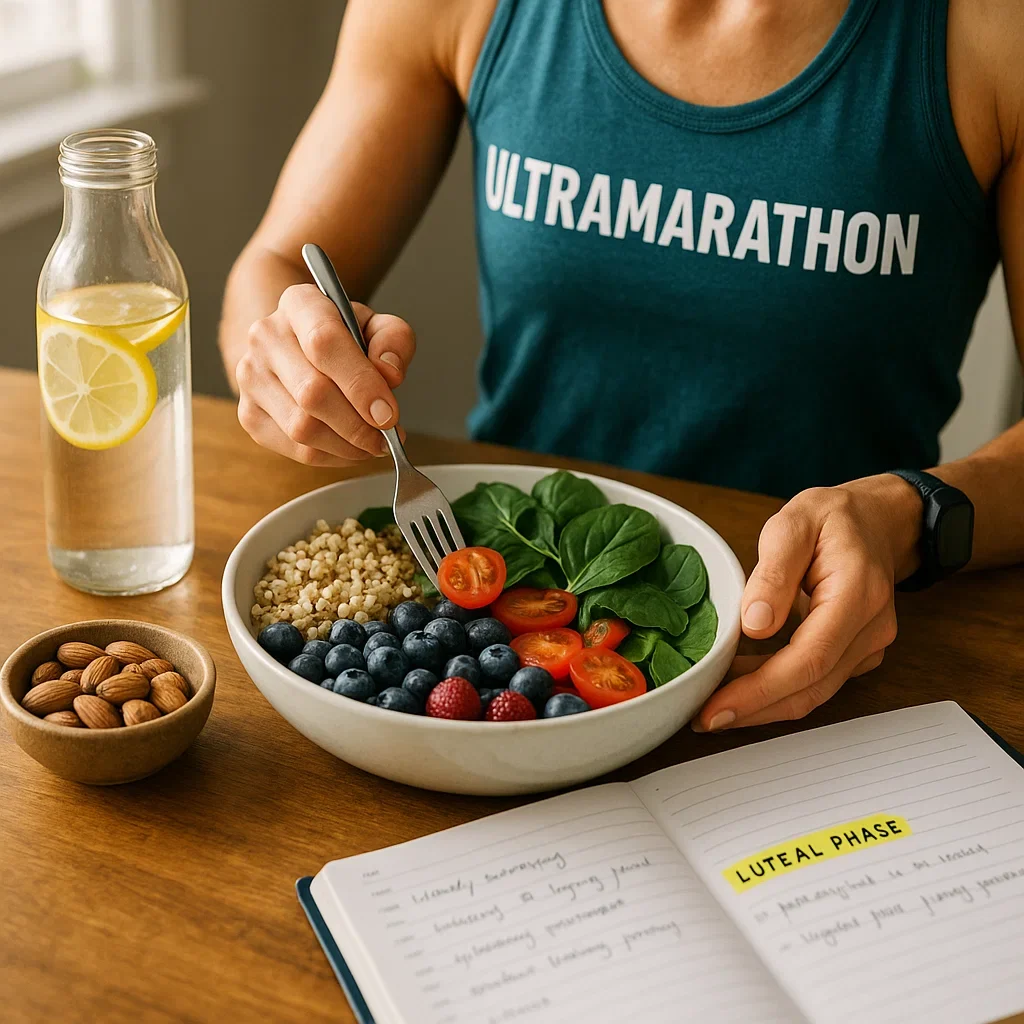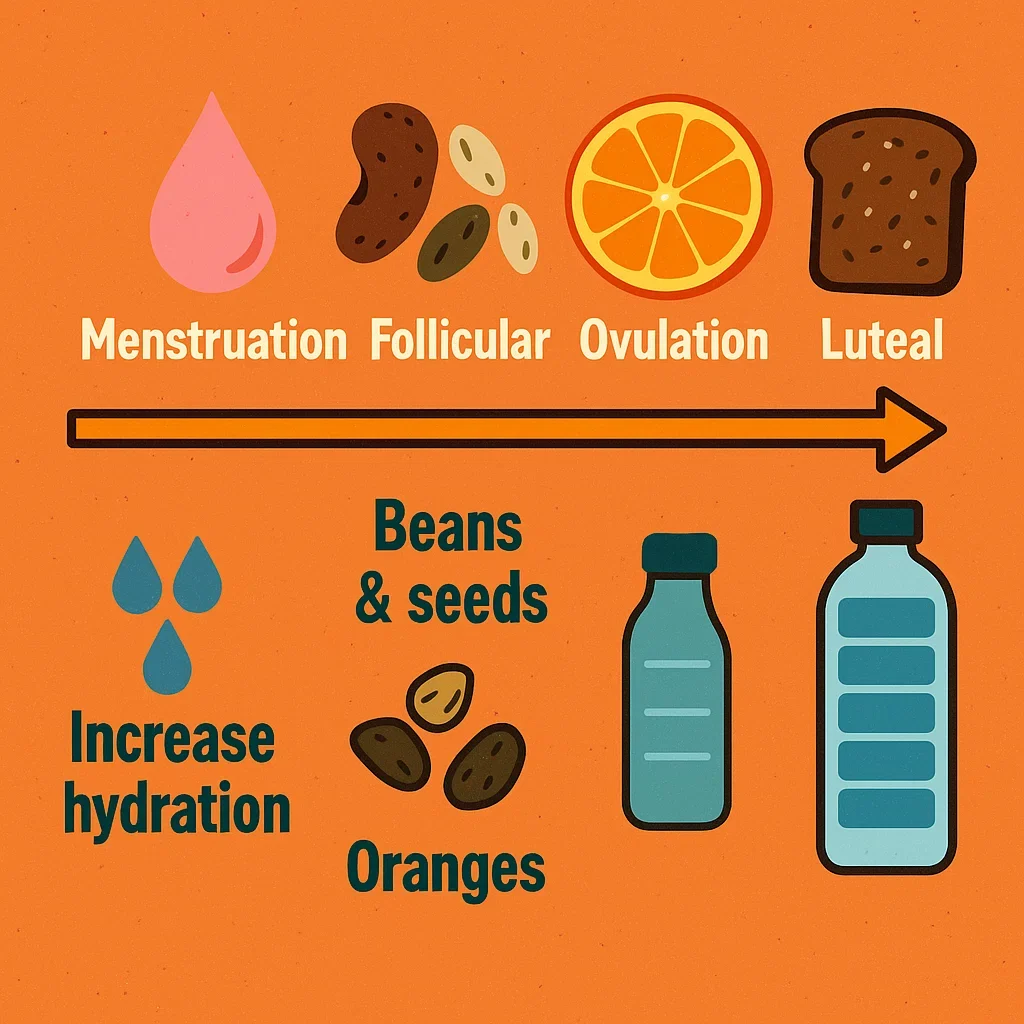Nutrition and Hydration Strategies for Ultramarathoners During the Menstrual Cycle
Nutrition and hydration are the hidden engines of every ultrarunner’s performance—but for women, the body’s needs don’t stay the same from week to week. Hormones fluctuate, metabolism shifts, cravings change, and even your hydration status responds to the phases of your menstrual cycle.
This guide unpacks the science and real-life strategies that help female ultrarunners fuel, hydrate, and recover smarter—no matter which day of the month you pin on a race bib. From iron timing to electrolyte tweaks, every phase can be an opportunity, not an obstacle.
What you’ll learn:
• How estrogen and progesterone impact fueling
• Phase-by-phase nutrition and hydration tactics
• Sample menus, supplement advice, and real-world tips
How Hormones Influence Fueling and Hydration
Two main hormones—estrogen and progesterone—shape your cycle and your body’s nutritional needs. As they rise and fall, so do energy demands, sweat rate, and even your gut’s tolerance for different foods.
- Estrogen: Rises in the follicular phase and peaks at ovulation. Improves fat metabolism, increases insulin sensitivity, and often boosts appetite and mood.
- Progesterone: Dominates the luteal phase. Raises core temperature, can make you sweat more, and sometimes slows digestion—leading to bloating, cravings, and a need for more hydration and electrolytes.
What does this mean for ultrarunners? Each phase can affect how you burn fuel, absorb nutrients, and stay hydrated. Tuning your nutrition and hydration to your cycle is a game-changer for both performance and recovery.
How Hormones Influence Fueling and Hydration
Two main hormones—estrogen and progesterone—shape your cycle and your body’s nutritional needs. As they rise and fall, so do energy demands, sweat rate, and even your gut’s tolerance for different foods.
- Estrogen: Rises in the follicular phase and peaks at ovulation. Improves fat metabolism, increases insulin sensitivity, and often boosts appetite and mood.
- Progesterone: Dominates the luteal phase. Raises core temperature, can make you sweat more, and sometimes slows digestion—leading to bloating, cravings, and a need for more hydration and electrolytes.
What does this mean for ultrarunners? Each phase can affect how you burn fuel, absorb nutrients, and stay hydrated. Tuning your nutrition and hydration to your cycle is a game-changer for both performance and recovery.
Nutrition Strategies for Every Cycle Phase
Menstruation (Days 1–5):
- Iron Replenishment: Menstrual bleeding means iron loss. Prioritize beans, lentils, leafy greens, seeds, dried fruits, and—if needed—supplements.
- Anti-Inflammatory Foods: Help cramps and soreness with berries, turmeric, chia, walnuts, and ginger.
- Manage Cravings: Go for whole carbs, dark chocolate, and healthy fats instead of processed sweets.
Follicular Phase (Days 6–13):
- Carbohydrate Loading: Estrogen increases glycogen storage. Boost complex carbs before big sessions: oats, quinoa, whole grain bread.
- Protein for Muscle Repair: Quick recovery window—up your plant or animal protein intake post-workout (tofu, tempeh, beans, protein shake).
- Appetite Support: Your hunger may rise; trust it and fuel for performance.
Ovulation (Day 14):
- Antioxidants: Combat increased inflammation risk. Add colorful fruits and veggies, especially berries, citrus, beets.
- Hydration Focus: Body temp is up; increase water and electrolytes.
- Steady Energy: Maintain balanced meals with slow carbs and lean protein.
Luteal Phase (Days 15–28):
- Magnesium: Helps with cramps, sleep, and mood. Eat nuts, seeds, spinach, banana, dark chocolate.
- Stable Blood Sugar: Frequent, smaller meals prevent crashes. Pair carbs with protein or healthy fats.
- Bloating/Cramps: Limit processed salt, increase potassium-rich foods (potato, avocado), drink peppermint tea.
Lost Pace tip: If your appetite or digestion feels “off,” try more smoothies, soups, or energy bites for easy fueling.
Hydration Tips: Adapting Fluid & Electrolyte Intake
- Menstruation: Blood loss means greater risk of dehydration. Start the day with a big glass of water, add a pinch of salt or lemon to aid absorption.
- Follicular/Ovulation: Sweat rate can increase as hormones peak. Carry an electrolyte mix on long runs. Look for sodium, potassium, and magnesium—not just plain water.
- Luteal Phase: Progesterone raises core temp and fluid loss. Track sweat with weigh-ins pre- and post-run. If bloated, drink smaller amounts more often and avoid carbonated drinks.
- Hydration cues: Dry lips, dark urine, headache, and sudden fatigue all signal the need to hydrate ASAP.
- Extra: Caffeine and alcohol dehydrate faster during some phases. Limit both the day before a long run or race.
Pro tip: Add a splash of fruit juice to your water if you can’t stomach sports drinks or want a quick carb + sodium combo on hot days.
Sample Meal & Hydration Plans for Every Phase
Menstruation Example:
- Breakfast: Overnight oats with chia, berries, and pumpkin seeds + orange juice
- Snack: Hummus with red pepper strips + herbal tea
- Lunch: Lentil soup, whole wheat pita, mixed greens
- Hydration: Water + electrolyte tab (esp. after runs)
Follicular Phase Example:
- Breakfast: Tofu scramble with spinach, mushrooms, and potatoes
- Snack: Banana with nut butter
- Lunch: Quinoa salad with chickpeas, avocado, cherry tomato
- Hydration: Water, plus sports drink during intervals
Ovulation Example:
- Breakfast: Oatmeal with walnuts, blueberries, and a little honey
- Snack: Greek yogurt (or plant-based alternative) with berries
- Lunch: Brown rice bowl with beans, broccoli, and sesame
- Hydration: Lemon water, diluted orange juice mid-run
Luteal Phase Example:
- Breakfast: Smoothie with spinach, banana, cocoa, flaxseed, oat milk
- Snack: Handful of pumpkin seeds and dried apricots
- Lunch: Sweet potato, black beans, greens, tahini sauce
- Hydration: Water with pinch of sea salt, peppermint tea after din
Sample Meal & Hydration Plans for Every Phase
Menstruation Example:
- Breakfast: Overnight oats with chia, berries, and pumpkin seeds + orange juice
- Snack: Hummus with red pepper strips + herbal tea
- Lunch: Lentil soup, whole wheat pita, mixed greens
- Hydration: Water + electrolyte tab (esp. after runs)
Follicular Phase Example:
- Breakfast: Tofu scramble with spinach, mushrooms, and potatoes
- Snack: Banana with nut butter
- Lunch: Quinoa salad with chickpeas, avocado, cherry tomato
- Hydration: Water, plus sports drink during intervals
Ovulation Example:
- Breakfast: Oatmeal with walnuts, blueberries, and a little honey
- Snack: Greek yogurt (or plant-based alternative) with berries
- Lunch: Brown rice bowl with beans, broccoli, and sesame
- Hydration: Lemon water, diluted orange juice mid-run
Luteal Phase Example:
- Breakfast: Smoothie with spinach, banana, cocoa, flaxseed, oat milk
- Snack: Handful of pumpkin seeds and dried apricots
- Lunch: Sweet potato, black beans, greens, tahini sauce
- Hydration: Water with pinch of sea salt, peppermint tea after dinner
Hydration timing: Drink 300–500 ml water 1–2 hours pre-run, 100–200 ml every 20–30 min during long runs, and replenish with an electrolyte drink post-run.
Supplements for Endurance, Recovery & Symptom Relief
- Iron: If your period is heavy or your ferritin is borderline, talk to a doctor about low-dose iron—especially post-period.
- Magnesium: Eases cramps, sleep trouble, and PMS. Try dietary sources first, but consider supplements (200–400 mg/day) in the luteal phase if needed.
- Vitamin D: Especially for winter or low sun exposure. Key for bone health and recovery.
- Omega-3s: Reduce inflammation and may ease period pain. Flaxseed oil, walnuts, or algae-based supplements are plant-based options.
- Other: Curcumin, ginger, and B-vitamins support energy and reduce inflammation.
- Avoid: Mega-doses, “fat burners,” or untested herbal blends—always consult a registered sports dietitian or physician before starting new supplements.
Lost Pace advice: The basics—food first, test with bloodwork, individualize your supplement routine. Track what truly helps your recovery and symptoms.

❓ FAQ: Nutrition, Hydration & the Menstrual Cycle
💧Should I drink more water during my period?
Yes—blood loss means greater risk of dehydration. Start each day with water, and be mindful of salt/electrolyte balance.🥗What foods help with PMS and cramps?
Magnesium-rich foods, anti-inflammatory ingredients (turmeric, ginger), and complex carbs ease symptoms. Avoid processed sugar and too much salt.🦴When is iron intake most important?
After your period, when iron stores are lowest. Combine iron-rich foods with vitamin C for better absorption.🍌How do I handle nausea or appetite loss?
Opt for smoothies, crackers, dried fruit, or small bites throughout the day—especially late luteal and early menstruation phases.🥤Are sports drinks better than water?
For long or hot runs, yes—choose drinks with sodium, potassium, and a bit of carbohydrate. For daily hydration, plain or infused water is fine.📚 Further Reading & Resources
Final Thoughts & Action Steps
There’s no “one-size-fits-all” nutrition plan for the female ultrarunner. But by tuning in to your cycle, experimenting with fueling and hydration strategies, and tracking what works, you’ll unlock new levels of energy, resilience, and performance.
Trust your body’s signals. Feed it, hydrate it, and treat every phase as an opportunity for growth—on and off the trail.
Lost Pace
About the Author
Lost Pace is an ultramarathon runner, shoe-tester and the founder of umit.net. Based year-round in Türkiye’s rugged Kaçkar Mountains, he has logged 10,000 + km of technical trail running and completed multiple 50 K–100 K ultras.Blending mountain grit with data, Lost analyses power (CP 300 W), HRV and nutrition to craft evidence-backed training plans. He has co-written 260 + long-form guides on footwear science, recovery and endurance nutrition, and is a regular beta-tester of AI-driven coaching tools.
When he isn’t chasing PRs or testing midsoles, you’ll find him sharing peer-reviewed research in plain English to help runners train smarter, stay healthier and finish stronger.
Ultrarunner · Data geek · Vegan athlete



